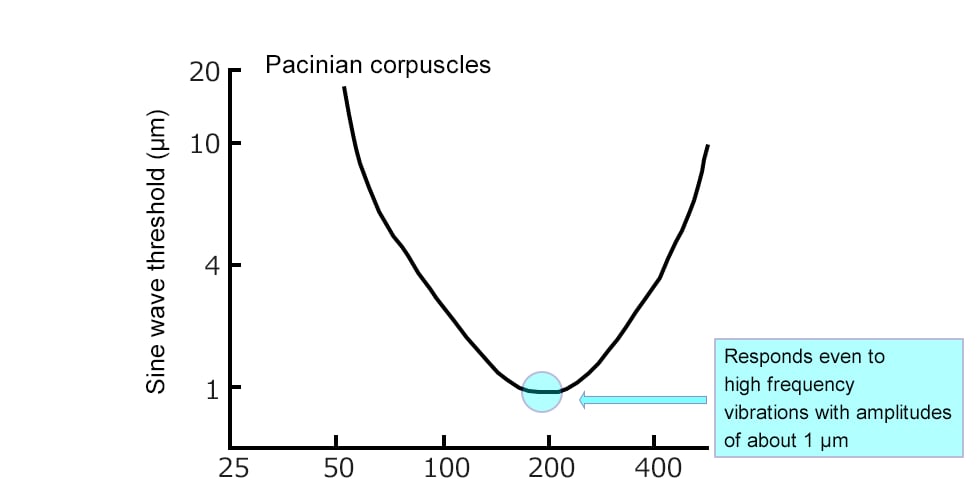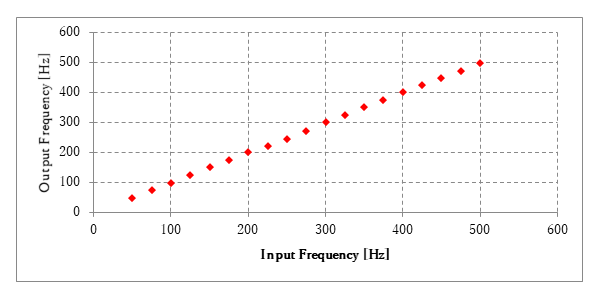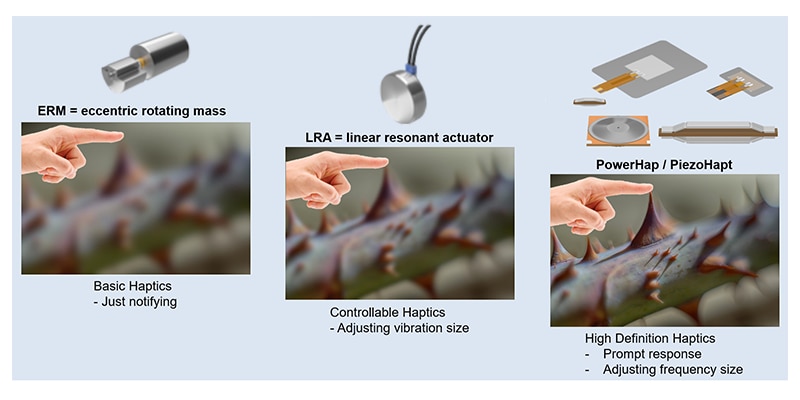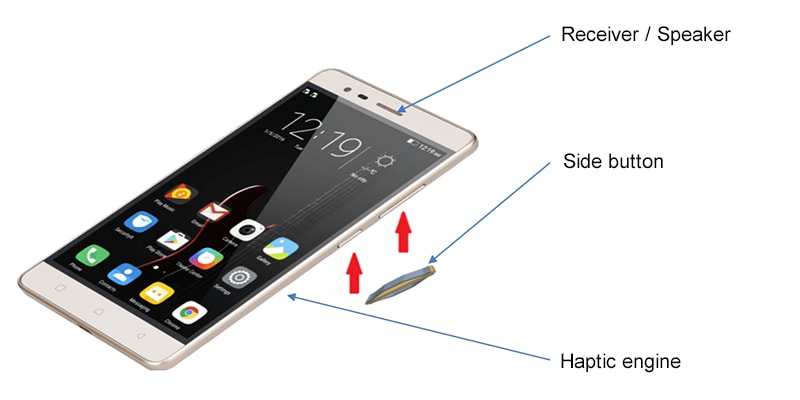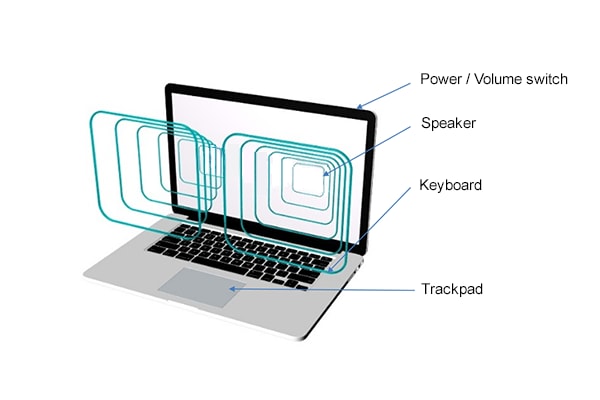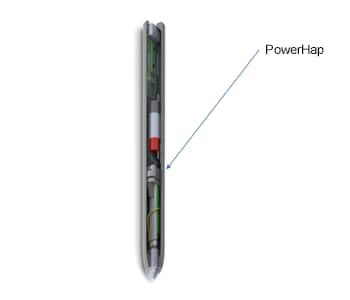Tech Notes
Application Note Piezo Haptic Devices for a Real Sense of Touch
Haptic devices are starting to be used for applications such as industrial or automotive monitors, displays on white goods such as washing machines, etc. However, these devices are also suitable for smartphones, notebook computers, and other ICT products.TDK offers haptic device products utilizing the piezoelectric effect.
Contents
The human sense of touch
The human five senses (sight, hearing, touch, taste, smell) are supported by 'sensors' that work in different ways. In particular, the sense of touch relies on the skin covering the entire body to provide sensory information, making it the largest sensory organ among the five senses.
So-called Pacinian corpuscles located under the skin are one of the sensor types responsible for the actual sense of touch. The graph shown at left illustrates the function of these Pacinian corpuscles. (The smaller the sine wave threshold, the higher the sensitivity.)
From the graph it can be seen that humans are able to perceive vibrations in the frequency range of about 50 to 500 Hz as a sense of touch, and that the sensitivity is especially high around 200 Hz.
Why are products using the piezoelectric effect (i.e. piezoelectric devices) superior as haptic devices?
Two types of products that are currently in wide use as haptic devices are Eccentric Rotating Mass (ERM) and Linear Resonant Actuator (LRA).
ERM products can only vibrate with a sine wave at a specific frequency. In the case of LRA products, the frequency and amplitude can be adjusted to a certain degree, but because the resonance frequency of the product itself is around 150 to 300 Hz, finely detailed tactile control is difficult to achieve.
By contrast, the resonance frequency of a piezoelectric element is in the tens of kHz, which does not affect the sense of touch. Therefore it is possible to freely control the vibrations in the important range of 50 to 500 Hz, creating tactile sensations that closely resemble the real sense of touch. (The graph below shows an example of the input / output response of a TDK product.)
Because it is not possible to depict actual differences in touch sensation, this explanation uses the visual sense instead.
The vibration produced by an ERM device simply indicates that "something is there" but provides no further information, which is represented by the blurred picture at left.
With an LRA device, shapes can be discerned to a certain extent, but details are still lacking, so the picture is still somewhat blurry.
A piezoelectric device provides detailed information and therefore allows the identification of details.
Furthermore, the piezoelectric element can be made smaller and thinner than ERM or LRA devices, which is especially desirable in the ICT sector where miniaturization is a major consideration.
An additional application of piezoelectric elements
So far, the explanation focused on the sense of touch (tactile sensation), but as mentioned above, piezo elements have a very high resonance frequency (several tens of kHz). This indicates that a very wide range of vibration frequencies can be created, including the range of human hearing (generally taken to be 20 Hz–20 kHz), which means that the element can also be used as a speaker. Piezoelectric elements can be used not only for the sense of touch but also the sense of hearing.
- PiezoHapt™ Actuators Product Information
- A comprehensive guide to various information concerning TDK Group's PiezoHapt™ Actuators
- PowerHap Actuators Product Information
- A comprehensive guide to various information concerning TDK Group's PowerHap Actuators
- PiezoListen™ Piezo Speakers Product Information
- A comprehensive guide to various information concerning TDK Group's PiezoListen™ Piezo Speakers
Usage examples in the ICT sector
This section introduces some ways in which piezo elements can prove useful in the ICT sector.
Receiver / speaker
By gluing TDK's PiezoListen™ Piezo Speakers product to the housing or the display, a sound slot such as used with conventional technology is no longer needed.
Side button
Besides functioning as an actuator, the piezo element can also serve as a sensor (turning pressure into an electrical signal). Positioning a PowerHap Actuators product under the housing allows elimination of the switch cutout. With a suitable driver IC the PowerHap Actuators can function both as a pressure sensing button and an actuator. By controlling the electrical signal supplied to the actuator, it is also possible to create various tactile sensations.
Haptic engine
Suitable placement of PiezoHapt™ Actuators and PowerHap Actuators products can be used to create a haptic engine for reproducing a variety of tactile sensations.Depending on the application, the PiezoListen™ Piezo Speakers can also be used.
Power / volume switch
Similar to the use as a smartphone side button, the PowerHap Actuators can eliminate the need for a switch hole, which improves design flexibility and can also serve to enhance waterproofing.
Speaker
Similar to the smartphone application, a sound opening is not required, allowing the PiezoListen™ Piezo Speakers to be placed behind the display. Because sound and visuals come from the same location, the enjoyment of video information is enhanced.
Keyboard, trackpad
Taking advantage of the characteristics of the piezoelectric element, a thinner and higher-performance keyboard and trackpad can be realized.
Integration of PowerHap Actuators in a stylus makes it possible to reproduce the feeling of different writing situations.
(For example using a pencil, ballpoint pen, or fountain pen, or writing on paper, stone, or wood)
Providing haptic feedback for wearables etc.


